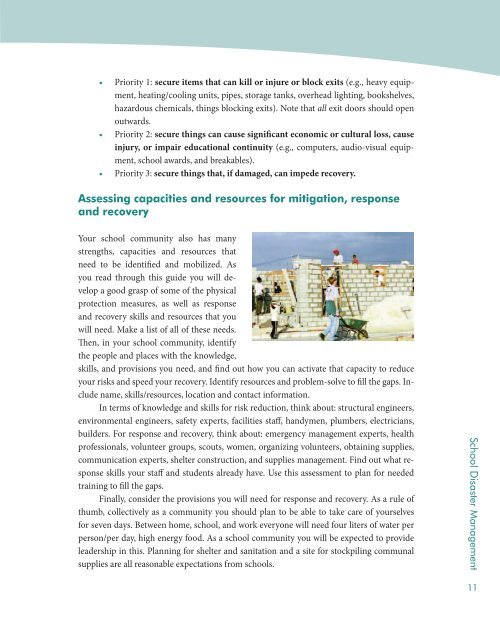Disaster and Emergency Preparedness: Guidance for ... - INEE Toolkit
Disaster and Emergency Preparedness: Guidance for ... - INEE Toolkit
Disaster and Emergency Preparedness: Guidance for ... - INEE Toolkit
You also want an ePaper? Increase the reach of your titles
YUMPU automatically turns print PDFs into web optimized ePapers that Google loves.
Priority 1: secure items that can kill or injure or block exits (e.g., heavy equipment,heating/cooling units, pipes, storage tanks, overhead lighting, bookshelves,hazardous chemicals, things blocking exits). Note that all exit doors should openoutwards.Priority 2: secure things can cause significant economic or cultural loss, causeinjury, or impair educational continuity (e.g., computers, audio-visual equipment,school awards, <strong>and</strong> breakables).Priority 3: secure things that, if damaged, can impede recovery.Assessing capacities <strong>and</strong> resources <strong>for</strong> mitigation, response<strong>and</strong> recoveryYour school community also has manystrengths, capacities <strong>and</strong> resources thatneed to be identified <strong>and</strong> mobilized. Asyou read through this guide you will developa good grasp of some of the physicalprotection measures, as well as response<strong>and</strong> recovery skills <strong>and</strong> resources that youwill need. Make a list of all of these needs.Then, in your school community, identifythe people <strong>and</strong> places with the knowledge,skills, <strong>and</strong> provisions you need, <strong>and</strong> find out how you can activate that capacity to reduceyour risks <strong>and</strong> speed your recovery. Identify resources <strong>and</strong> problem-solve to fill the gaps. Includename, skills/resources, location <strong>and</strong> contact in<strong>for</strong>mation.In terms of knowledge <strong>and</strong> skills <strong>for</strong> risk reduction, think about: structural engineers,environmental engineers, safety experts, facilities staff, h<strong>and</strong>ymen, plumbers, electricians,builders. For response <strong>and</strong> recovery, think about: emergency management experts, healthprofessionals, volunteer groups, scouts, women, organizing volunteers, obtaining supplies,communication experts, shelter construction, <strong>and</strong> supplies management. Find out what responseskills your staff <strong>and</strong> students already have. Use this assessment to plan <strong>for</strong> neededtraining to fill the gaps.Finally, consider the provisions you will need <strong>for</strong> response <strong>and</strong> recovery. As a rule ofthumb, collectively as a community you should plan to be able to take care of yourselves<strong>for</strong> seven days. Between home, school, <strong>and</strong> work everyone will need four liters of water perperson/per day, high energy food. As a school community you will be expected to provideleadership in this. Planning <strong>for</strong> shelter <strong>and</strong> sanitation <strong>and</strong> a site <strong>for</strong> stockpiling communalsupplies are all reasonable expectations from schools.School <strong>Disaster</strong> Management11
















